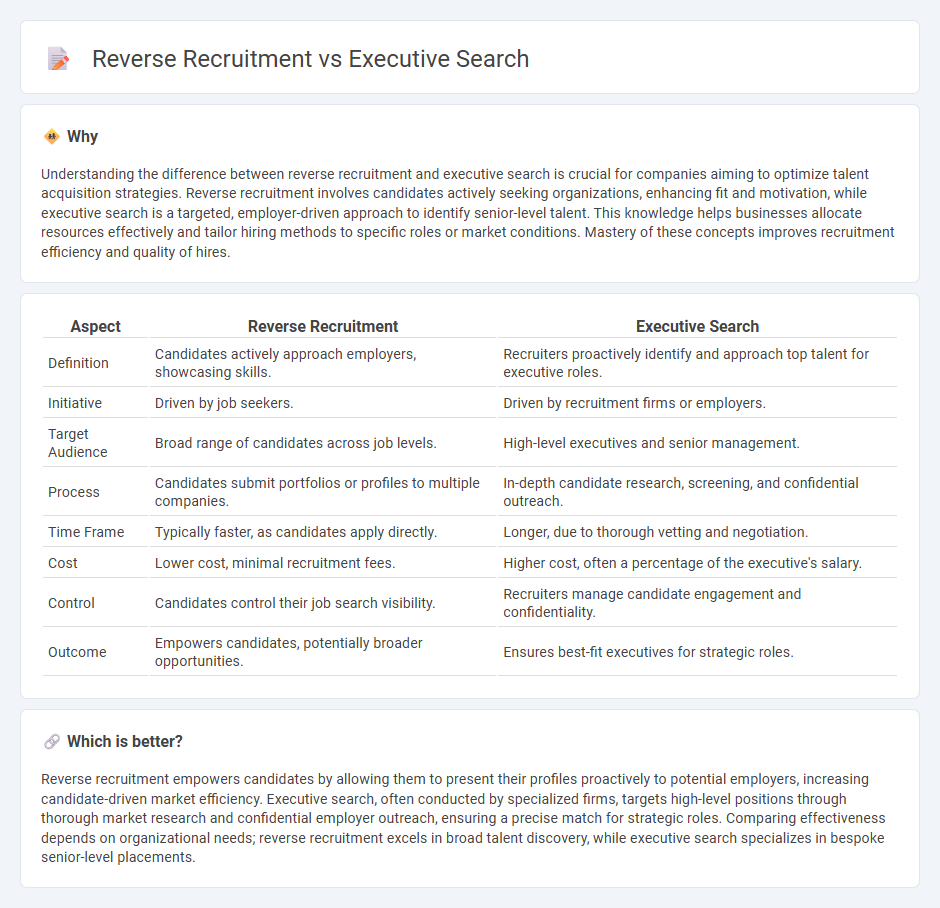
Reverse recruitment empowers candidates to proactively engage employers by showcasing their skills and career goals, shifting the traditional hiring dynamic. Executive search firms specialize in identifying and attracting top-level talent for leadership roles, leveraging extensive networks and industry expertise to meet organizational needs. Discover how these innovative hiring strategies can transform your employment approach.
Why it is important
Understanding the difference between reverse recruitment and executive search is crucial for companies aiming to optimize talent acquisition strategies. Reverse recruitment involves candidates actively seeking organizations, enhancing fit and motivation, while executive search is a targeted, employer-driven approach to identify senior-level talent. This knowledge helps businesses allocate resources effectively and tailor hiring methods to specific roles or market conditions. Mastery of these concepts improves recruitment efficiency and quality of hires.
Comparison Table
| Aspect | Reverse Recruitment | Executive Search |
|---|---|---|
| Definition | Candidates actively approach employers, showcasing skills. | Recruiters proactively identify and approach top talent for executive roles. |
| Initiative | Driven by job seekers. | Driven by recruitment firms or employers. |
| Target Audience | Broad range of candidates across job levels. | High-level executives and senior management. |
| Process | Candidates submit portfolios or profiles to multiple companies. | In-depth candidate research, screening, and confidential outreach. |
| Time Frame | Typically faster, as candidates apply directly. | Longer, due to thorough vetting and negotiation. |
| Cost | Lower cost, minimal recruitment fees. | Higher cost, often a percentage of the executive's salary. |
| Control | Candidates control their job search visibility. | Recruiters manage candidate engagement and confidentiality. |
| Outcome | Empowers candidates, potentially broader opportunities. | Ensures best-fit executives for strategic roles. |
Which is better?
Reverse recruitment empowers candidates by allowing them to present their profiles proactively to potential employers, increasing candidate-driven market efficiency. Executive search, often conducted by specialized firms, targets high-level positions through thorough market research and confidential employer outreach, ensuring a precise match for strategic roles. Comparing effectiveness depends on organizational needs; reverse recruitment excels in broad talent discovery, while executive search specializes in bespoke senior-level placements.
Connection
Reverse recruitment and executive search both focus on aligning top talent with organizational needs by targeting high-level professionals through proactive strategies. Executive search firms specialize in identifying and attracting candidates for senior positions, while reverse recruitment empowers candidates to present themselves to potential employers, creating a dynamic two-way hiring process. Together, they enhance talent acquisition by facilitating direct engagement between executives and companies.
Key Terms
Headhunting
Executive search targets top-level talent through proactive identification and direct engagement by specialized headhunters, ensuring a tailored fit for critical leadership roles. Reverse recruitment flips the process, where candidates actively seek executive opportunities by showcasing their skills to recruiters, fostering a more candidate-driven dynamic. Explore in-depth comparisons to understand which headhunting method aligns best with your organizational hiring strategy.
Candidate-driven process
Executive search targets top-tier talent through proactive sourcing by recruiters, emphasizing employer needs, whereas reverse recruitment centers on candidates actively seeking opportunities, driving the process based on their preferences and qualifications. The candidate-driven approach in reverse recruitment enhances alignment between job seekers' aspirations and organizational culture, resulting in higher retention and satisfaction rates. Explore deeper insights into how candidate-driven strategies transform talent acquisition.
Talent acquisition
Executive search specializes in identifying and recruiting high-level executives through targeted headhunting, leveraging extensive networks and industry expertise to secure top leadership talent. Reverse recruitment shifts the dynamic by empowering candidates to actively seek and attract employers, facilitating a proactive approach in the talent acquisition process. Explore these innovative strategies to enhance your understanding of modern talent acquisition methods and optimize your hiring outcomes.
Source and External Links
Executive Search - Korn Ferry - Executive search firms identify and recruit highly qualified candidates for senior and C-suite roles by creating a detailed "Success Profile," targeting candidates through research and networks, and qualifying prospects to fill key organizational leadership positions effectively.
Cowen Partners Executive Search | Top Executive Recruiters - This firm specializes in connecting companies with top 1% executive talent across the C-suite and leadership roles, delivering placements within about six weeks through a meticulous search process for diverse organizations including pre-IPO and non-profits.
Executive Search | Russell Reynolds Associates - Utilizing a data-driven and innovative assessment approach, this firm places exceptional C-suite and senior leaders worldwide, providing a qualified candidate shortlist typically within eight weeks, focusing on quality and efficiency across industries.
 dowidth.com
dowidth.com